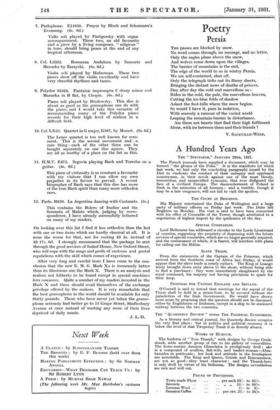Gramophone Notes
A YEAR ago I published a list of twelve discs which could boast classical music, a good tune, and first-class repro- duction. Each disc contained either a single movement of a larger work or a complete work in itself ; a rule which cut out most of the finest quartets and symphonies since the companies always contrive to split movements on two discs even when this is not necessary. Apparently my suggestion that the twelve would make a perfect present for English exiles abroad was taken seriously and I have had many requests from recipients to publish another list, Here it is ; twelve discs each with six or seven minutes' happiness or peace which can be transported to the Congo, the Amazon or the Ganges.
1. H.M.V. D 1835. Overture to Barber of Seville. (6s. 6d.) Played by the New York Philharmonic and conducted by Toscanini, this is perhaps the best piece of cheerful music from all points of view of 1930.
2. Col. DX60. Ballet music from Orpheus. Gluck. (4s. 64
Played by a French orchestra and made remark- able by a flute solo. A very gentle piece of music.
3. H.M.V. D1772. Third Symphony 8rd movement. Brahmi. (Os. 6d.)
A Stokowski disc as memorable in its way as the very popular last movement of the first sym- phony. Very good to whistle while gardening.
4. Col. LX60. Rose Cavalier Waltzes. I?. Strauss. (Os. 6 1. )
Bruno Walter conducts these with all the care he would put into a Mozart symphony : the result will please even a highbrow.
5. Col. 9929. Two songs from Henry Purcell's The Tempest. (4s. 6d.) Sung by Norman Allin. A very English pair of songs, by an English composer, sung by an English singer and recorded by an all-English company. Just the thing for export to thz outposts of Empire. But apart from these merits the neglected Purcell is here done honour and allowed to please.
6. Col. DB335. Clive Carey singing four English Folksongs. (3s.)
I will give my love an apple ; 0 Sally, my dear ; My boy Billy ; The Lover's Task. This disc seems to me quite the most universally attractive thing which has reached me during the last two years, and I have taken out of my list an old favourite to make room for it • certainly the best folksong record I have heard. 7. Parlophone. E11058. Prayer by Bloch and Schumann's Evensong. (4s. 6d.) 'Cello soli played by Piatigorsky with organ accompaniment. These two, an old favourite and a piece by a living composer, " religious " in tone, should bring peace at the end of any tropical afternoon.
8. Col. L2332. Romanza Andaluza by Sarasate and Mazurka by Zarzycki. (6s. 6c1.) Violin soli played by Huberman. These two pieces show off the violin excellently and have very cheerful rhythms and tunes.
9. Polydor 95324. Fantaisie impromptu C sharp minor and Mazurka in B flat, by Chopin. (Os. 6d.) Piano soli played by Bmilowsky. This disc is about as good as the gramophone can do with the piano, and I would take this occasion of recommending many of the Polydor piano records for their high level of realism in a difficult field.
10. Col. LX25. Quartet in G major, K387, by Mozart. (Os. 6d.) The Lener quartet is too well known for com- ment. This is the second movement and—a rare thing—each of the other three can be bought separately on one disc apiece. They are all as worthy of a place on the list as this.
11. H.M.V. E475. Segovia playing Bach and Torroba guitar. (4s. 6d.) This piece of virtuosity is so constant a favourite with my visitors that I can allow my own prejudice in its favour to prevail. A recent biographer of Bach says that this disc has more of the true Bach spirit than many more orthodox ones.
12. Parlo. R650. La Argentina dancing with Castanets. (3s.) This contains the Bolero of 'rather and the Serenata of Malats which, judging by corre- spondence, I have already successfully fathered on many of my readers.
On looking over this list I find it less orthodox than the last with one or two items which are hardly classical at all. It is none the worse for that, nor for costing £3 3s. instead of £8 17s. 6d. I strongly recommend that the package be sent through the good services of Imhof House, New Oxford Street, who will cope with the snags and perils of customs and postal regulations with the skill which comes of experience.
After very long and careful tests I have come to the con- clusion that the new E. M. G. Mark XA is immensely better than its illustrious sire the Mark X. There is an analysis and realism not hitherto to be found except in special machines hors commerce. Quite a number of my readers invested in the Mark X and these should avail themselves of the exchange privilege offered by the makers. It is very remarkable that the best gramophone in the world should be available for only thirty pounds. Those who have never yet taken the gramo- phone seriously had better go to 11 Grape Street, Shaftesbury Avenue at once instead of wasting any more of their lives deprived of daily music.
J. L.-D.







































 Previous page
Previous page